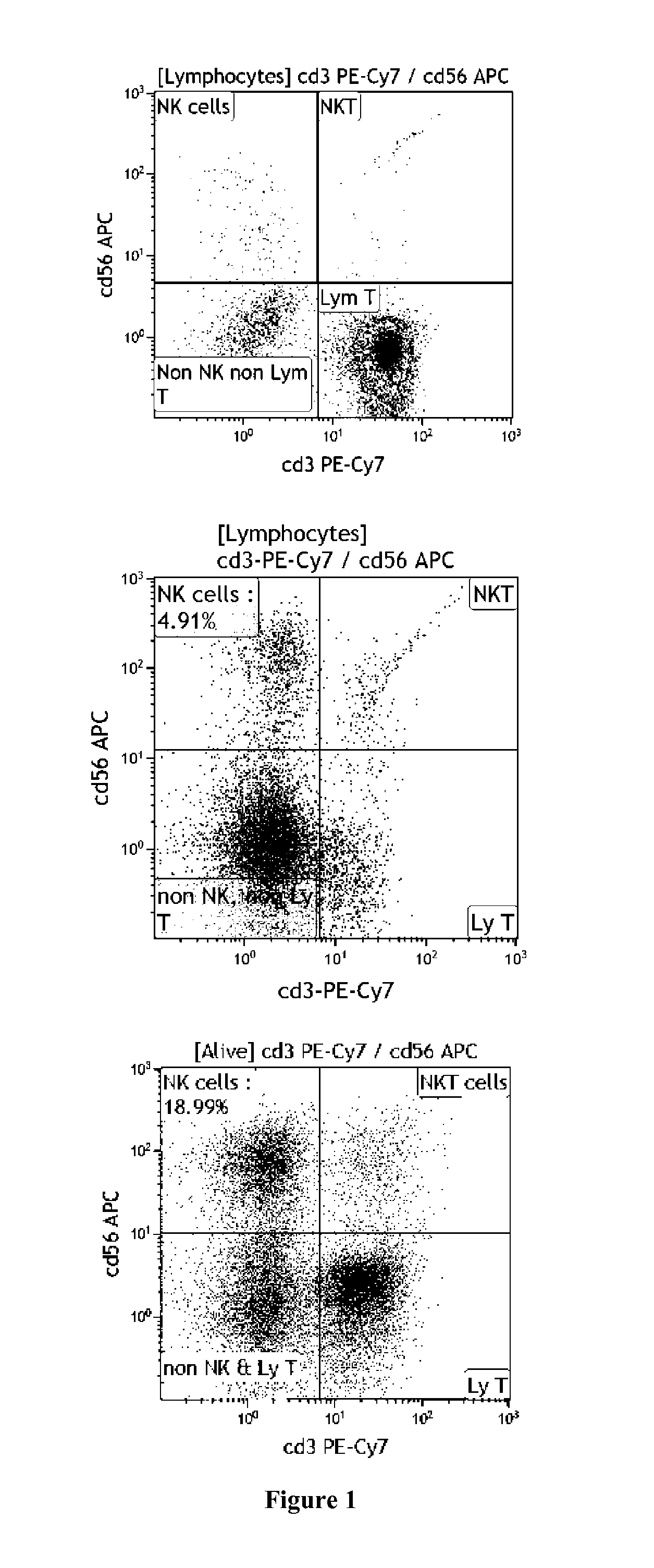Methods for preparing accessory cells and uses thereof for preparing activated nk cells
a technology of accessory cells and nk cells, which is applied in the field of accessory cells, can solve the problems of reducing the success of such transplants, reducing the efficiency of nk cells, and refractory patients to standard treatment, so as to improve the efficiency of nk cell activation and reduce the expression of erk5
- Summary
- Abstract
- Description
- Claims
- Application Information
AI Technical Summary
Benefits of technology
Problems solved by technology
Method used
Image
Examples
example 1
[0072]Most donors have the potential to exert NK cell alloreactions as they possess a full complement of inhibitory KIR. The genes for the HLA-C group1 receptor (KIR2DL2 and / or KIR2DL3) and the HLA-A3 / 11 receptor (KIR3DL2) are present in ˜100% of individuals; the genes for the HLA-C group2 receptor (KIR2DL1) and the HLA-Bw4 receptor (KIR3DL1) are found in 97% and 90% of individuals, respectively. These genes and their ligands are determined in the donor by KIR and HLA genotyping. We have generated a bank of EBV-accessory cells, which express all KIR ligands (C030) or totally lack their expression (721.221). Between these two opposite phenotypes, we have EBV-accessory cells that lack expression of only one MR ligand: HLA-C g1 (cell line PLH), HLA-C g2 (HOM-2), HLA-Bw4 (KT17), and HLA-A3 / 11 (Bri-P). The HLA-ligand mismatched EBV-accessory cell line may be thus use to induce preferential expansion of NK cells reactive to tumor cells lacking the selected HLA molecules. C030 and 721.221 ...
example 2
[0073]We hypothesized that by selecting the adequate EBV-cell line we can amplify a NK cell population expressing only a MR ligand. Results from two UCB units have confirmed this hypothesis. We obtained mononuclear cells from an mbilical cord blood (UCB) unit expressing HLA-Cg1 and HLA-Bw4 (see EXAMPLE 1). We incubate mononuclear cells with PLH, which lack HLA-Cg1 and KT17, which lack HLA-Bw4, cells in the presence of 100 U / ml of IL-2. We show that these accessory cells, i.e. KT17 or PLH, induce a large expansion of NK cells after ten days in co-culture (FIG. 1). Therefore, our accessory cells are immunologically competent to expand NK cells.
[0074]Moreover, PLH accessory cells, which lack HLA-Cg1, predominantly induce expansion of NK cells expressing KIR2DL2 / 3, which is the ligand of HLA-Cg1 alleles (FIG. 2). Ten days later we observed an increase of 17-times of expansion of NK cells expressing only KIR2DL2 / 3 when using PLH as accessory cells. Twenty days later this expansion reache...
example 3
[0075]Accessory or feeder cells induce a larger amplification of NK cells than interleukines. This is independent of the stimulation and the UCB. Other cell types such as T cells show minor expansion. NK cell expansion always works.
[0076]We obtain better results if we use the accesory / feeder cells alive (see FIG. 4). However it is necessary to optimize the protocol because NK cells need the continuous addition of feeder cells. In case of absence of re-stimulation with living cells, we observe better results with irradiated accessory cells. Our results suggest that depending the amount and frequency of alive feeder cells addition, the use of irradiated feeder cells or a small amount of alive feeder cells during the first 3 days greatly improve NK cell expansion.
[0077]Interestingly, our accessory cells keep NK cells expressing CD16. Therefore, these cells can mediate ADCC better than IL-2 expanded cells. In addition, accessory cells induce CD25 expression, whereas IL-2 fails to do it....
PUM
 Login to View More
Login to View More Abstract
Description
Claims
Application Information
 Login to View More
Login to View More - R&D
- Intellectual Property
- Life Sciences
- Materials
- Tech Scout
- Unparalleled Data Quality
- Higher Quality Content
- 60% Fewer Hallucinations
Browse by: Latest US Patents, China's latest patents, Technical Efficacy Thesaurus, Application Domain, Technology Topic, Popular Technical Reports.
© 2025 PatSnap. All rights reserved.Legal|Privacy policy|Modern Slavery Act Transparency Statement|Sitemap|About US| Contact US: help@patsnap.com



